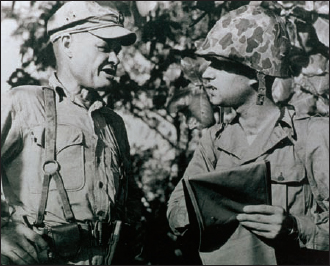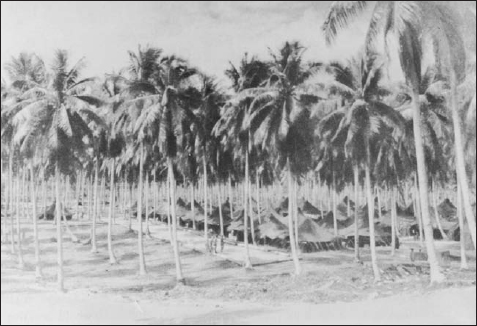
7 December Japanese bomb Pearl Harbor, Hawaii; simultaneously attacking the Philippines, Wake Island, Guam, Malaya, Thailand, Shanghai and Midway
10 December Japanese invade the Philippines and also seize Guam
23 January Japanese seize New Britain and New Ireland in the Bismarck Archipelago and Bougainville in the Solomon Islands
22 February President Roosevelt orders General MacArthur out of the Philippines
11 March General MacArthur leaves Corregidor and is flown to Australia. General Jonathan Wainwright becomes the new US commander in the Philippines
18 March General MacArthur appointed commander of the Southwest Pacific Theater by President Roosevelt
24 March Admiral Chester Nimitz appointed as Commander-in-Chief Pacific Fleet and Pacific Ocean Area
6 May Japanese take Corregidor as General Wainwright unconditionally surrenders all US and Filipino forces in the Philippines
4–5 June The turning point in the Pacific War; a decisive victory for the US against Japan in the Battle of Midway as squadrons of US torpedo planes and dive bombers from USS Enterprise, Hornet and Yorktown attack and destroy four Japanese carriers, a cruiser, and damage another cruiser and two destroyers. The US loses Yorktown.
21 July Japanese land troops near Gona on New Guinea
7 August The first US amphibious landing of the Pacific War occurs as 1st Mar. Div. invades Tulagi and Guadalcanal, Solomon Islands
18 October Vice Admiral William F. Halsey named as the new commander of the South Pacific Area, in charge of the Solomons–New Guinea campaign
9 February Japanese resistance on Guadalcanal ends
21 June Allies advance to New Georgia, central Solomon Islands
25 August Allies secure the New Georgia lodgment
1 November US Marines invade Bougainville, northern Solomon Islands
15 December US troops land on the Arawe Peninsula, New Britain, Bismarck Archipelago
26 December Full allied assault on New Britain as 1st Mar. Div. lands on Cape Gloucester, New Britain

Col Lewis B. “Chesty” Puller, Commander of the 1st Marines. He had served in the Caribbean, Haiti, Nicaragua and China before the war and had commanded a detachment of the famous Horse Marines in Shanghai in 1933, where he acquired an almost venomous dislike of the Japanese. He had commanded a battalion of the 7th Marines on Guadalcanal where he won his third Navy Cross. His versatility and leadership in New Britain earned him the promotion to command the 1st Marines by February 1944.
1–7 February US troops capture Kwajalein and Majura Atolls, Marshall Islands
17/18 February US carrier-based planes destroy the Japanese naval base at Truk Atoll, Caroline Islands
20 February US carrier-based and land-based planes neutralize the Japanese base at Rabaul, New Britain
24 April Japanese 14th Division arrives in the Palau Islands, Col Nakagawa and 10,500 troops are sent to Peleliu plus 1,400 to Angaur
29 May Operation Stalemate ordered by Admiral Nimitz, Commander-in-Chief, Pacific Ocean Areas (CINCPOA)
11 June US Marines and Army invade Saipan
19 June The “Marianas Turkey Shoot” occurs as US carrier-based fighters shoot down 220 Japanese planes while only 20 American planes are lost
7 July Operation Stalemate II – the revised plan for the invasion of the Palau Islands – is issued
18 July Prime Minister Tojo and the War and Navy Ministers are forced to resign when the invasion of Saipan is announced in Japan

Pavuvu Island was the staging area for the 1st Mar. Div. and rest and re-fit area after their fighting in the Solomons. It took the 1st Mar. Div. several months of hard work to turn Pavuvu into a habitable place. Conditions hardly helped men, most of whom were suffering from recurring bouts of malaria and other jungle diseases and as such were far from peak fitness. Coupled with the vast numbers of replacements, including for the first time draftees rather than volunteers, the 1st Mar. Div., although in theory at 100 per cent strength, was in fact far below this in terms of combat efficiency.
19 July US Marines and Army invade Guam, Mariana Islands
24 July US Marines invade Tinian, Mariana Islands
15 August American troops complete the capture of the Mariana Islands by securing Guam
27 & 29 August 1st Mar. Div. conducts practice landings for Peleliu at Tassafaronga, Guadalcanal
4 September Peleliu Attack Group departs Guadalcanal
13 September Admiral Halsey recommends the cancellation of Operation Stalemate II, but is told it is too late to cancel the invasion of Peleliu
15 September US troops invade Morotai Island, Netherlands East Indies and Peleliu Island, Palaus Islands
17 September 81st Infantry invade Angaur Island, south of Peleliu
21 September Angaur declared secure, 81st Inf. Div. available for redeployment to Peleliu
22 September 321st Regimental Combat Team begins to relieve 1st Marines on Peleliu
15 October 81st Inf. Div. relieves 1st Mar. Div. on Peleliu
20 October US Sixth Army invades Leyte in the Philippines
23–26 October Battle of Leyte Gulf results in a decisive victory for the US Navy
27 November 81st Inf. Div. declares Peleliu secure
15 December US troops invade Mindoro in the Philippines
3 January General MacArthur is placed in command of all US ground forces and Admiral Nimitz in command of all naval forces in preparation for planned assaults against Iwo Jima, Okinawa, and Japan itself
9 January US Sixth Army invades Luzon in the Philippines
19 February US Marines invade Iwo Jima
16 March US Marines secure Iwo Jima
1 April US Army and Marines invade Okinawa
22 June Japanese organized resistance ends on Okinawa
5 July Liberation of Philippines declared
14 July The first US naval bombardment of Japanese Home Islands
6 August First atomic bomb dropped on Hiroshima
9 August Second atomic bomb is dropped on Nagasaki – Emperor Hirohito and the new Prime Minister Suzuki then decide to seek an immediate peace with the Allies
2 September Formal Japanese surrender ceremony on board the USS Missouri in Tokyo Bay as 1,000 carrier-based planes fly overhead. President Truman declares V-J Day
21 April Lt Yamaguchi and 34 men surrender on Peleliu, the last formal surrender of World War II
Lone Korean laborer is last man to surrender on Peleliu